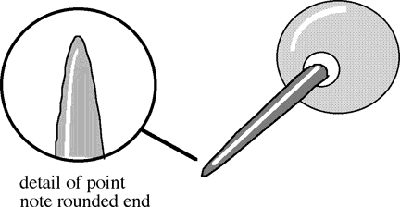Turning Burrs Into Stonesetting Tools
Stonesetters frequently convert and and reuse tools intended for other purposes. Often when a tool is needed they will cast around the bench looking for raw material - and as every setter knows, used burrs abound. There are a number of tools that can be made from such defunct burrs. One of the most useful of such setters tools is a point burnisher.
3 Minute Read
Stonesetters frequently convert and and reuse tools intended for other purposes. Often when a tool is needed they will cast around the bench looking for raw material - and as every setter knows, used (or tragically, even overheated, "burnt") burrs abound. There are a number of tools that can be made from such defunct burrs.
One of the most useful of such setters tools is a point burnisher. This is used for brightening up the inside rims of bezels, giving a sparkle to prong tips and even to confirm and complete the setting of flush set and snap set gems. This kind of point burnishing tool is made by taking an old or broken burr and sanding and grinding the end of it to a rounded point. If there is still a burr remnant on the end this is snapped off using a pair of pliers before you start reshaping it leaving a hardened steel shaft with a taper towards the end. An easy way to further taper and finish the tool is to mount the burr shank in a flex shaft handpiece and hold it against emery papers while it spins to sand it into the long, smooth taper required of a good point burnisher.
When reshaping the burr care is taken not to overheat it during abrasion and thus causing a loss of hardness (overheating destroys the temper of the burr). The very tip of the tapered shank is rounded very slightly and gently using emery papers and finally polished to a bright shine (my favorite polishing compound for this is Fabulustre®). While a reshaped burr is the best solution to my mind because the resulting tool is harder and lasts longer without repolishing, the actual rounded shape needed can be found in a set of tapestry or thick darning needles. It looks like a sharp point on such needles but when inspected under a loupe the end is actually rounded off nicely.
This tool can be mounted into a graver handle or held in a universal collet handle such as is used for beading tools and millgrain wheels. It is a great little burnisher for fine detailed work.
Setters use old burrs to make different sizes of beading tools using a steel beading block. The tools are used to round off the beads for pavé set gems. This rather antique approach to toolmaking is great for maintaining a set of varied sizes of beading tools. The beading block tool is expensive, maybe $70.00 or so. To use it you take an old burr, snap the burr itself off using a pair of pliers, grind the point off flat, then heat the end up red hot and hammer it swiftly and once into the beading block hole you want. If it is not yet formed properly reheat and do it again. The beading block will have rows of the same size of holes to form the beading tool. This is because the heat damages the shaping holes with time and so having more than one to replace those worn out is useful. When the burr has been reshaped properly into a beading tool then it is hardened and tempered to a straw yellow color on the tip. Finally it is lightly polished.
An old burr can also be used to create a round graver for raising beads used in pavé settings. Take a damaged burr, snap the end off, then grind and sharpen the tapered round cross section to an angle. The tool is set into a universal graver holding handle or a graver handle and is used for pushing the base of the bead against the gemstone to set it. Different sizes are easy to make, just grind further up the tapered round shank.
You assume all responsibility and risk for the use of the safety resources available on or through this web page. The International Gem Society LLC does not assume any liability for the materials, information and opinions provided on, or available through, this web page. No advice or information provided by this website shall create any warranty. Reliance on such advice, information or the content of this web page is solely at your own risk, including without limitation any safety guidelines, resources or precautions, or any other information related to safety that may be available on or through this web page. The International Gem Society LLC disclaims any liability for injury, death or damages resulting from the use thereof.
Charles Lewton-Brain
Master goldsmith Charles Lewton-Brain trained, studied and worked in Germany, Canada and the United States to learn the skills he uses. Charles Lewton-Brain is one of the original creators of Ganoksin.
The All-In-One Jewelry Making Solution At Your Fingertips
When you join the Ganoksin community, you get the tools you need to take your work to the next level.
Trusted Jewelry Making Information & Techniques
Sign up to receive the latest articles, techniques, and inspirations with our free newsletter.
